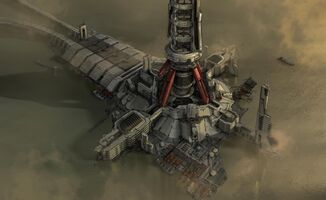
Puná Orbital Elevator in Ecuador West Coast.
An Orbital Elevator is a piece of infrastructure on a planet where ships can dock and transfer people or cargo to and from land into orbit. Elevator's locations are selected to optimize access to land and navigable water and for commercial demand. Some elevators have an important military role, like Palau Lingga.
Space elevators are a common construction of the UN and the UNCA, both on Earth and her colonies. There are eleven of them on Earth.
It is the safest and cheapest way to travel off-world, hoarding the vast majority of traffic between Earth and its colonies.
Orbital Elevators are the safest and most popular way to get off-world. More than 500 million trips were made trough an elevator from Earth in 2170.
Another advantage of them are their low costs compared to that of traditional spaceports, thus they are regarded by many as a transport for the "plebs". A trip from Gornayinsk Spaceport (Russian Siberia) to a low orbit station for a proper scale costs ₡13.000 while a ticket on Nairobi Spaceport costs ₡3.200.
Structure[]
The top of the elevator (referred to as The Terminal) is commonly composed by a huge space dock capable to handle hundreds of ships and thousands of people at the same time. The biggest Terminal is Nairobi Spaceport's, capable to attend 70 major vessels at a time, 102 minor hangars and capacity to handle 650,000 people daily.
The orbital elevators consist of a single tether reaching into space, surrounded by additional strands. The lower part of the tether is surrounded by an additional support frame. All of them are designed to be high-capacity cargo elevator systems.
Ground terminals – commonly referred as The Base, are always well connected with terrestrial transport infrastructure as MagLev Train lines and Seaports for cargo, and Vacuum Trains and Airports for passengers.
It takes an average of 6 days to get from the base to the top. According to Singapore Spaceport's VI a trip from the Base to the Terminal should take exactly 8,611m. and 34s.
Logistics[]
In order to effectively manage the huge amounts of goods and people that move through the elevator huge facilities and processing capacities are needed.
The Cars, as they are known, are 20 stories high cabins that run along the cable from the Base to the Terminal. There are 400 hundred of them working all the time alongside the cable with a capacity of up to 5,000 people at a time. There are cabin departures every 45 minutes on average.
The docking areas and the minor hangars are kept up by super intelligent VIs that monitors that embarkation and disembarkation activities are run with maximum efficiency. Delays of 28s. upwards are considered unimaginable. Every ship that intends to dock at one elevator must book a week in advance or it should wait up to one day until a bay is available. During The Wars, with the military having top priority, traffic was limited to military craft, people and goods; while waiting times rose up to a week for civilians.
Orbital Elevators in operation[]

Terminal of Nairobi's Space Elevator
- Amazonia (North of Manaus)
- Colombo
- Nairobi
- Depok
- Kuching
- Libreville
- Macapá (on the Amazon's Delta)
- Maldives
- Pacifica (on the bedrock of what once was Kiribati)
- Palau Lingga
- Panam/Europe
- Puná (Ecuador)
- São Tomé e Príncipe
Orbital Elevators outside Earth[]

The Base of Kuching Space Elevator
While Earth has eleven orbital elevators, some other planets colonized and developed by humans have some since there is a heavy human reliance on the production and shipment of agricultural and mineral goods from remote worlds in addition of the necessity for moving massive numbers of people.
- Mars: Mars' low gravity made interest in building an orbital elevator minimal at the beginning, but as martian economy grew, so did its necessity for cheaper transportation in order to keep the planet's resource competitive compared to those on the Asteroid Belt. Today it has three orbital elevators: Nea Damascus, Port Faubelle, and Carson City.
- Imvusa Ikhaya: The government of the colony has already built 3 orbital elevators that are now in operation (Jotunheim, Peng Lai & Varos City), with one more under construction.
- Domus Ruber: One Orbital Elevator is in operation (Nandakanana) and 2 more are under construction.